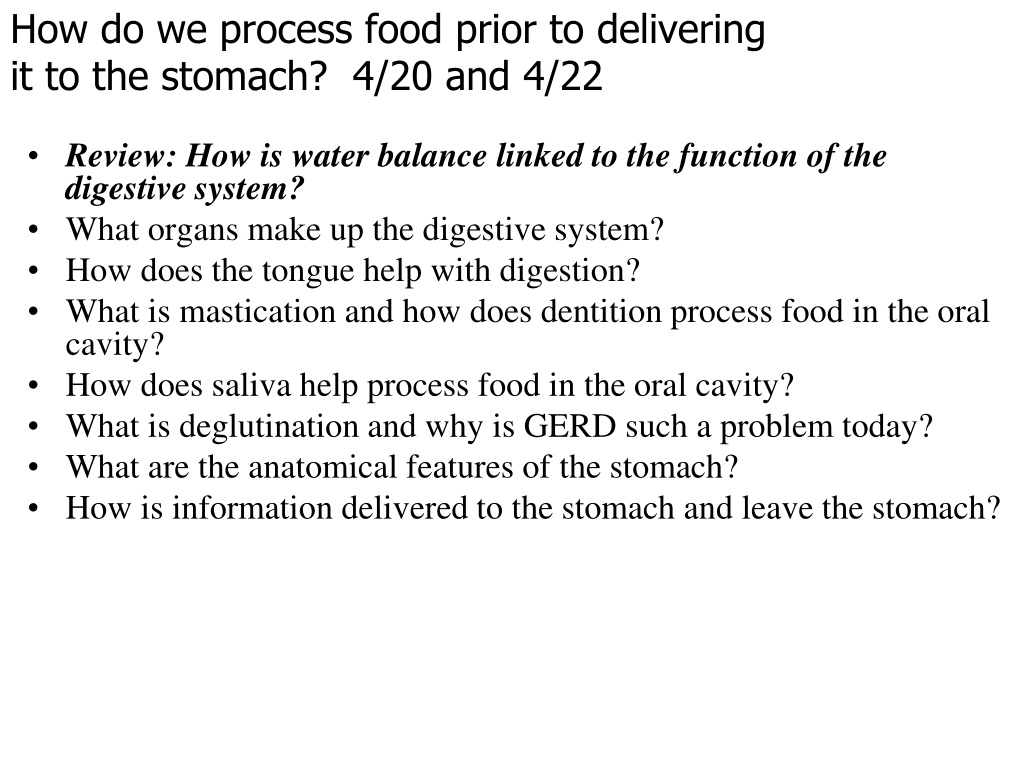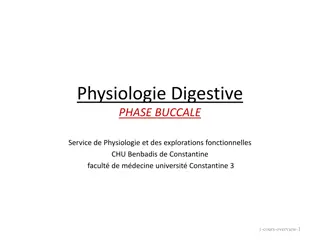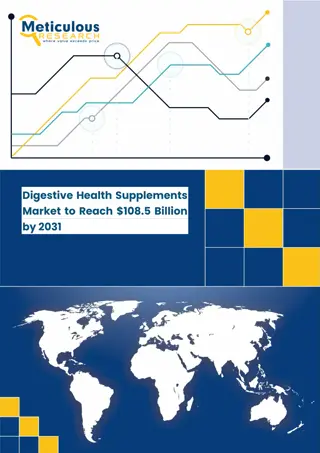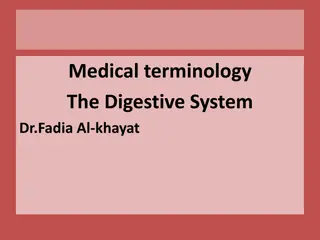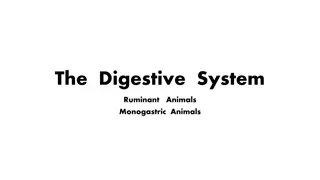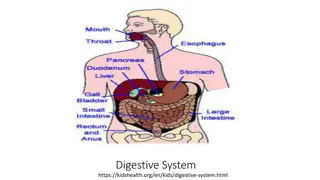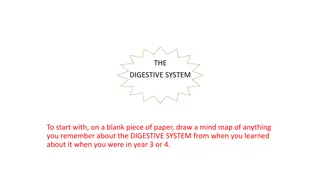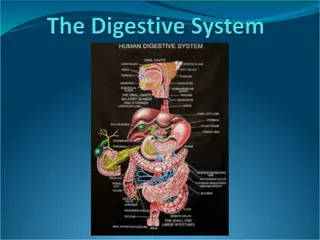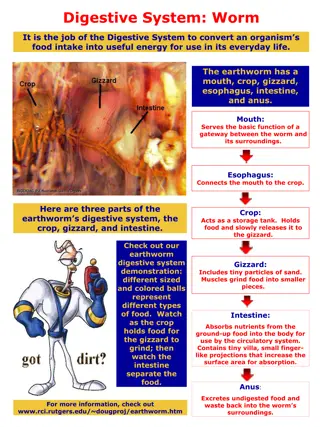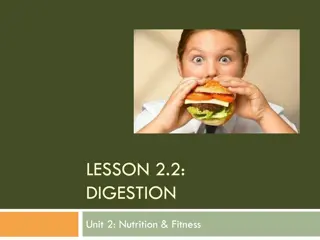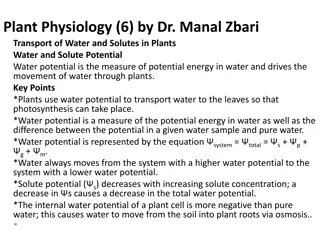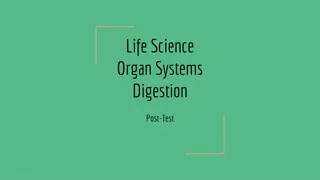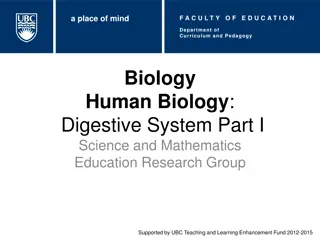Water Balance and Digestive System Function
This content delves into the intricacies of water balance, digestive system function, and the critical role of water in the body. It discusses how water is distributed, sources of water intake, methods of water loss, and the importance of maintaining water homeostasis for overall health.
Download Presentation

Please find below an Image/Link to download the presentation.
The content on the website is provided AS IS for your information and personal use only. It may not be sold, licensed, or shared on other websites without obtaining consent from the author.If you encounter any issues during the download, it is possible that the publisher has removed the file from their server.
You are allowed to download the files provided on this website for personal or commercial use, subject to the condition that they are used lawfully. All files are the property of their respective owners.
The content on the website is provided AS IS for your information and personal use only. It may not be sold, licensed, or shared on other websites without obtaining consent from the author.
E N D
Presentation Transcript
How do we process food prior to delivering it to the stomach? 4/20 and 4/22 Review: How is water balance linked to the function of the digestive system? What organs make up the digestive system? How does the tongue help with digestion? What is mastication and how does dentition process food in the oral cavity? How does saliva help process food in the oral cavity? What is deglutination and why is GERD such a problem today? What are the anatomical features of the stomach? How is information delivered to the stomach and leave the stomach?
HOW IS THE FLUID VOLUME DETERMINED BY SALTS, H2O, GFR AND DISTRIBUTION OF GFR IN THE KIDNEY? How much water does our body contain (Total Body Water)? Infant: 65-75% Young Adult: 55-60% Obese and Elderly: 40-50% Your Total Body Water Content: 70 kg X 55% = about 40L Where is this 40L of water distributed in your body? Intracellular: 65% (40L X 0.65)= 26L Extracellular: 35% (40L X 0.35)= 14L 25% Interstitial Water (between cells) (40L X 0.25)= 10L 8%Water in blood and Lymph (40L X 0.08)= 3.2L 2%Trancellular water (endoplymph, joints, cerebral spinal fluid, pericardial and pleural fluids) (40L X 0.02)= 0.8L TQ: please memorize these numbers! VIP Clinical applications! What are the Sources of the 2.5 L/day water you normally receive? Preformed (2.3 L/day) vs. Metabolic water (0.2 L/day) Drinks and Food Aerobic Respiration
HOW DOES OUR WATER EXIT THE BODY? Water Loss Routes are varied: Urine (1.5 L/day), Transpiration (0.4L/day), Sweat (0.1 L/day, Breathing (0.3 L/day), Feces (0.3 L/day or 10L/day diarrhea?), Vomiting (0-10 L/day??) Insensible Water Loss: Not obvious or conscious loss Obligatory Water Loss: Totally unavoidable loss How can water loss (dehydration) become very severe very fast? Consider Diarrhea or Vomiting (Water AND IONS can be lost!) Consider Sweating on a hot dry day (up to 5 L/day or more lost!) Consider Breathing rate and water loss when you are on top of Pike s Peak CO (up to a 1.5 L/day) The water volume is certainly NOT static, it changes constantly! What happens if you do not adapt to the water loss? What happens to kidney function under extreme conditions? Why is maintenance of WATER HOMEOSTASIS so critical?
Water Homeostasis is one of the most important types of balance we must maintain. Each Day: 2,500 ml IN/ 2,500 ml OUT HOW IS THIS BALANCE ACCOMPLISHED? A Rough Approximation for Water Needs in Athletes: If you are counting calories in a person, you use up about 1 gram of water for every calorie you burn.
The digestive system consists of several organs that break up food, swallow, enzymatically digest nutrients in chyme, propel these materials from the mouth to the anus, and absorb nutrients into the blood. Overview:
Digestion starts with food ingestion, gustation, and mastication in the oral (buccal) cavity. It all starts with taste! 4 types of tongue taste bud: front-back/Left-right Unami is the fifth taste Sweet-energy Salt-sodium Sour-acidic Bitter-alkaline/poison Palatability and ingestion: Flavor-Aroma-Texture As we age we become less able to taste and smell! Importance for hypertension and anorexia in elderly?
Mastication: We use teeth, tongue, lips and cheeks to begin the mechanical aspects of the digestive process. Mechanical function of tongue lingual muscles, lips and cheeks: The Parts of a Tooth: Enamel Dentin Pulp Cavity Root Canal Alveolar Bone Occlusion: Occlusal Surface: Cusps:
We will normally have 20 deciduous milk teeth. After the age of 6, these are replaced by 32 (4X8)permanent teeth that provide for us in adulthood. Adults: 32 Permanent Teeth Each Quadrant has 8 teeth: 2 incisors-cut 1 canine-hold 2 premolars-sheer 2 molars-grind 1 Wisdom tooth The last to erupt! Bones: Maxilla or Mandible 4X Quadrants= 32 teeth Infants: 20 Deciduous Teeth As the permanent teeth erupt, they push the deciduous teeth out of their sockets! Teething
How does a lack of oral health hamper good nutrition and digestion? Dentition determines if you eat, grind, digest, talk, and even sleep efficiently! Who is susceptible to problems? Why? Plaque: Calculus or Tartar Flossing and brushing Caries: Digestive enzymes and acids Grinding Out and Fillings as a solution Root Canal Therapy: Pulp replacement Infection removed Gingivitis can lead to Peridontal Disease? How is tooth loss related to our diet in the USA, Third World, and in Prehistoric Peoples?
We produce saliva (1.5 L/day) for 3 reasons: 1) Lubrication/moisture of food during mastication 2) Mix enzymes for digesting bacteria, starch and lipids 3) Addition of NaCO3- for control of acidity/tooth decay Parotid (20%): Serous Sublingual (5%): Mucous Submandibular(70%): Mixed Minor glands (5%) Saliva Contents: Water: Main Content! Electrolytes:K+, Cl-, NaCO3- Proteins: Mucin and IgA Enzymes active only at pH 7: Lingual amylase Lysozyme Lingual Lipase active in stomach Bites often bring infection! WHY?
Deglutination: the tongue presses a food bolus against the palate, through the fauces, into the pharynx, past the epiglottis and into the esophagus. Then peristaltic waves of smooth muscle squeeze it into the stomach as the cardiac sphincter relaxes. Activity coordinated by swallowing center of medulla:22 muscles Three Stages to Swallowing: 1) Buccal > 2) Pharyngeal > 3) Esophageal Entry into esophagus (skeletal then smooth muscle) creates a peristaltic wave in the muscularis externa that generates propulsion by shortening and narrowing the tube right-behind the bolus! Enteric Nervous System allows for conduction of depolarization along smooth muscle cells resulting in a wave of contraction! Finally: Lower esophageal sphincter must relax (dilate) before bolus can pass through the cardiac orifice into the stomach!
Gastro Esophogeal Reflux Disease (GERD)is a huge problem for many people! Have you seen adds for the Purple Pill called Prilosec ?
Stomach: Provides for Mixing, Acidification and Sterilization
There are several important anatomical structures on the stomach that you should be aware of. Why are these clinically significant? Location inferior to the diaphragm and left lung Esophageal sphincter and diaphragm Pyloric sphincter Pyloric Canal Fundic, Cardiac and Pyloric Regions and the Body Greater and Lesser Curvatures Converting ingested material into Chyme: Gas and the cause of indigestion:
The layers of the stomach are all responsible for specific functions,,,what are these layers? Serosa: (formerly called adventitial layer on esophagus) Muscularis Externa: three smooth muscle layers Longitudinal Circular Oblique Provide mixing across three different orientations Submucosa: Contains blood vessels and nerves Mucularis mucosa: tiny muscle layer under mucosa Mucosa: Contains arterioles, venules, capillaries, lymphatics, gastric pits/ducts, stomach does huge amount of work here! (ATP production required!) Epithelial layer protection!
It is also important to remember that a layer of protective glycocalyx coats and protects all underlying simple columnar epithelial cells from acids!
How do we bring information, oxygen, nutrients, and blood into or out of the stomach? Blood: Enters via gastric branch of celiac trunk artery Exits via hepatic portal vein for cleaning of blood toxins in liver Information: Enters via two nerves: Vagus Nerve: parasympathtic info to stomach Vagus Nerve also carries sensory info from stomach to brain Sympathetic fibers of celiac ganglion Hormones: Gastrin: output hormone to blood CCK, GIP and Secretin: Input hormones from blood Lymphatics are also very important for fluid drainage/inflammation!
What digestive materials are secreted by the stomach and how do we protect ourselves against them? Stomach makes acids, pepsin and huge amounts of mucus Importance of mucus: PROTECTION OF EPITHELIUM! Importance of stomach acid: Antibacterial Digestion Nutrient availability Problem with stomach acids: Potential self digestion: stomach, esophagus, duodemum Potential enzyme de-activation due to pH Importance of Pepsin: Break up proteins and Deactivate potential hazards Potential to autodigest your own body Solution: activation only in acidic pH What happens to pepsin activity if Tums are taken?
Small Intestine: Three sections Duodenum-First 5% Section (12 fingers-12 inches) from pyloric sphincter PAST sphincter of oddi: Goal-neutralize stomach acid Jejunum- empty Second 35% Section: Goal- enzymatic degradation and nutrient absorption Ileum- Third 60% Section: goal nutrient absorption before passage into cecum Ileocecal Valve- passage into Large Intestine Key Intestinal Items from Outside->Inside Serosa-Longitudinal SCM-Circular SMC-Submucosa-Mucosa-Villi and Lacteals-Columnar epithelial tissue-Microvilli-BrushBorder
